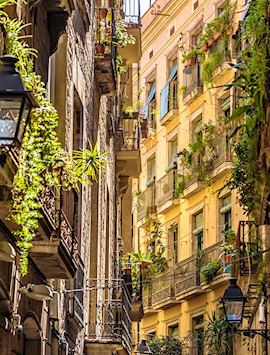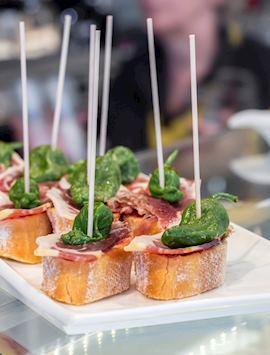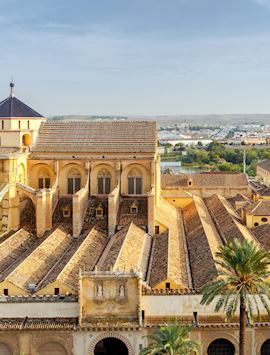From convivial tapas to crowd-sized pans of paella, social life in Spain revolves around food. Professional chefs and home cooks alike draw on a long culinary tradition that takes advantage of the country’s abundant sun, fertile soil and access to the rich waters of the Mediterranean.
Lunch is the biggest and longest meal of the day. Served in the early afternoon, it’s a multi-course affair with generous portions. If time allows, we suggest lingering over your meal and avoiding the heat of midday. And, as the sun sets, you can join the crowds who spill into the streets and plazas to make a light meal out of tapas.
Here, our specialists offer a sampling of the best dishes and food-related tours that they’ve enjoyed in Spain.
Jamón ibérico
By Allan
As you drive through the Spanish southwest, you’ll see lithe black pigs capering about the countryside. Lean, dark and primeval, they roam freely through the oak-and-cork forests, rooting for acorns and grubs. These black Iberian pigs are the source for jamón ibérico, Spain’s complex artisanal ham.
In Seville, you can attend a jamón tasting with a cortador profesional de jamón — a professional ham slicer. Flamboyantly passionate about his calling, my cortador began by explaining the different grades of ham. The highest quality comes from pigs that were allowed to wander freely their whole lives and fed on acorns. Their diet ensures that the meat is exceptionally rich, heavily marbled with veins of golden fat that glisten in the light.
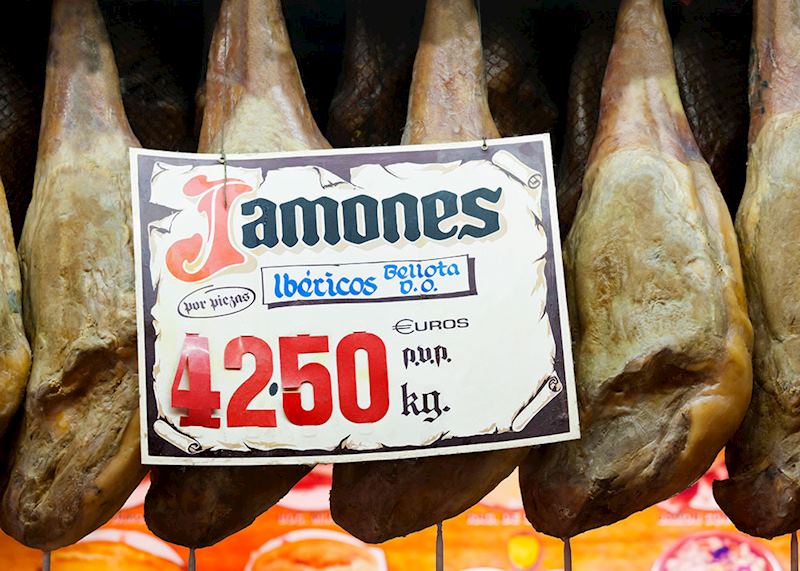
Slicing as he talked, he gently coaxed off pieces from the joint in a dance-like movement. He kept his long, narrow knife moving slowly in small circles, paring off slices so thin that you could see the light through them. Even the slicing of the ham is considered an art form in itself, with the aim to get just the right blend of meat and marbled fat in each slice. Making a poor cut can be an expensive mistake — this prized ham can cost several hundred euros a leg. Intensely nutty, the meat seemed to dissolve on my tongue.
The cortador explained that the best varieties exhibit the same sort of terroir you can find in fine wines. Hams from near the coast differ from those farther inland, a factor of the pigs’ diet, the climate and the microflora of each area.
If you enjoy the tasting, you can also see the pampered lives (and carefully controlled afterlives) of the pigs. At a small farm an hour west of Seville, I watched a clutch of pigs joyfully gorging themselves on acorns, snorting and grunting at each other. The pigs were wholly free range and foraged for themselves, the farmer told me, as well as on their feed of acorns gathered from the nearby oaks.
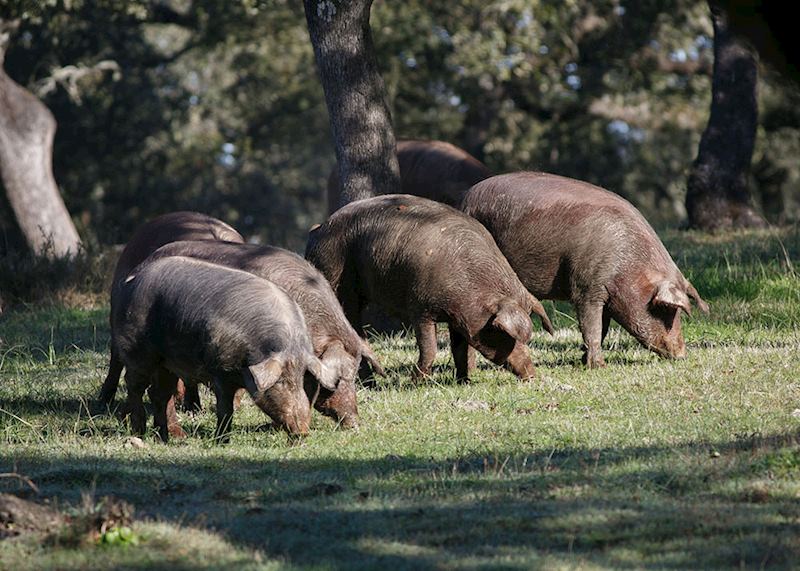
Once they’ve eaten, the cheerful pigs are trotted up a low hill to their ‘spa’, a shallow mud wallow carefully positioned out of the wind to keep their sensitive skin from getting chapped.
Donning protective gear, including stylish white-paper booties, I moved onto the processing plant. My guide talked through each stage in the long process of making the delicacy: butchering, salting, washing, drying, culturing and, finally, aging. This last step took place in a vast room nicknamed a cathedral, its peaked ceiling heavily hung with legs of ham dangling from metal hooks. It offered a rare look into the ancient process that created this local delicacy.
Paella
By Sarah
I grew up with seafood-based paellas, but the precise composition of this saffron-scented rice dish varies depending on the region, the season, what looks good at the market and the whim of the chef.
In Barcelona, I took a paella-cooking class with a chef from the city named Carlos. We began by shopping at La Boqueria — a vast indoor market that dates back to at least the 13th century. It was a Monday and in Spain, you simply do not buy fish on Mondays because Sunday is a rest day for the fisherman and Monday’s catch will not have arrived yet. Instead, we bought fresh chicken from a butcher who cut it to size, deftly slicing the flesh into hefty paella-sized cubes.

Back at the kitchen, Carlos pulled out a large carbon-black paella pan, twice the size of a manhole cover, and heated it over what looked like a giant Bunsen burner. Though a two-person pan fits neatly on a normal cooktop, the larger family-sized pans don’t, and many homes have special rigs to heat the larger surface area.
Carlos walked me through creating a paella, underlining the importance of moving the rice only in the early stages. It’s vital to let it sit undisturbed if you want to form socarrat, the crispy, crunchy crust at the bottom that’s caused by the grains of rice frying in the mingled oil and rendered chicken fat.
What surprised me most was his generous hand with the saffron. Spain is a key producer of Saffron, one of the world’s most expensive spices, and while not as dear as in the States, Carlos still poured out a whole palm-full — perhaps as much as a half-ounce. When he crushed the delicate spice with his fingers, he released a scent that was gently floral and slightly bittersweet, like dark honey. In the pan, the saffron bloomed in the rich simmering liquid, sending up coils of fragrant steam.
When we sat down to enjoy our efforts, I was amazed at the depth of taste we’d managed to achieve, even without seafood. The subtle spice, tender meat and crunchy socarrat combined to create a toothsome medley that left me resolved to use much more saffron in the future.
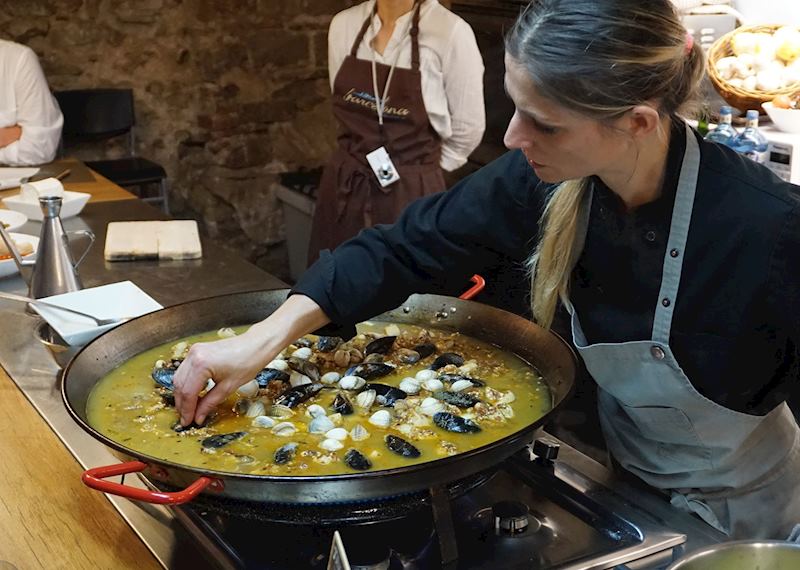
Basque Country cuisine
By Rob
With 78 Michelin rated restaurants and 32 Michelin stars, the Basque Country has long been known for its exceptional cuisine. Yet why is this region such a hotbed of culinary innovation? One big explanation is the region’s gastronomic societies.
Almost every city boasts a host of these private clubs that have doubled as cultural institutions where locals (traditionally just men) meet to cook and eat together, for centuries. During the Franco dictatorship, these tightly-knit private societies were particularly important as they were among the few places where Basque language and culture could flourish. Here locals share recipes and techniques, as they urge each other to greater culinary heights. Over the years, these hothouses have produced some exceptional chefs, as well as residents who appreciate excellent food.
Normally, the world of the Basque gastronomic society is hidden to visitors, but recently one club in Bilbao has started offering you a rare glimpse inside its walls.
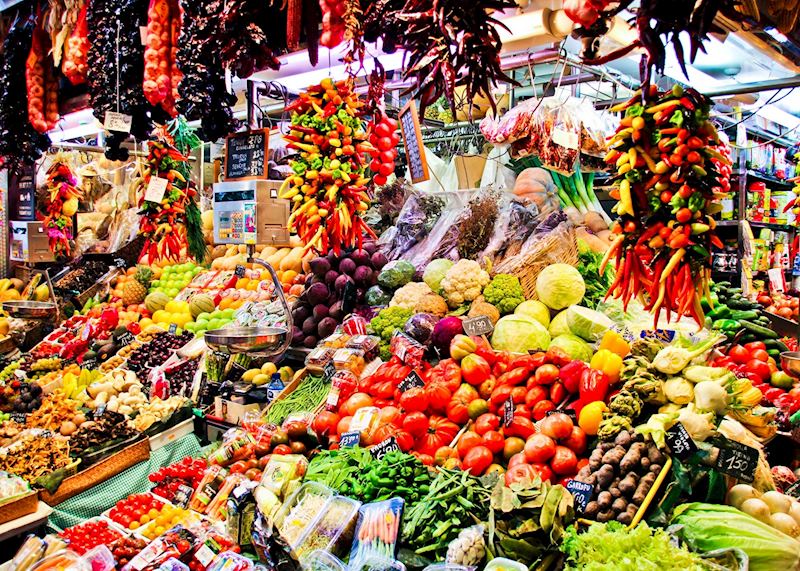
On a recent visit I enjoyed lunch cooked by a number of local gentlemen, clattering pans and dicing vegetables. Through an interpreter, I learned about the history of the societies in general and that club specifically. I got to see the dog-eared book where members jotted down what they’d used from the general pantry and the bulletin board where they pinned up slips to reserve time in the kitchen.
Then I sat at one of the long bench tables draped with a blue-and-white checked cloth, to enjoy a convivial lunch of fried peppers and slow-cooked ox cheek, swapping stories with my hosts.
Tapas (and pintxos)
By Geoff
Called pintxos in the north and tapas everywhere else, small plates are universal across Spain. Shared with friends or enjoyed over a drink, they help to foster the convivial street life for which the country is known.
The stories behind tapas are varied, from a tragic tale about a man dying from a hornet in his drink, to a more pedestrian account about drinkers who stepped away from the bar for a cigarette and wanted to keep flies out of their beer. Regardless, the original tapas were likely just cheese or ham served on toast that could cover a drink — the name comes from the word tapar, to cover.
In the Basque Country, the name pintxos comes from pinchar, to pierce. Here, the food is more often pinned to the toast with a toothpick.

Many bars offer them for free alongside your drink, especially in the late afternoon or early evening. One or two makes a nice midday snack, to carry you to the late dinner times the Spanish prefer. To make a meal of them, I suggest ordering three plates or so per person to share among your group.
There are so many tapas bars — called tascas — that a local guide can be handy to find the best plates at the best bars, especially in the big cities like Barcelona, Seville and Madrid.
I think that the most intriguing tapas (or pintxos, to be accurate) tour you can take is with a guide named Gabrielle in San Sebastián. In the undisputed gourmet capital of Spain, even a small plate of grilled foie gras was elevated to high art.
When I took the tour recently, the best dish I tried was braised rabbit, cooked to succulent shreds and lightly napped by a light sauce. Alongside was a golden-brown nest of fried potato strings, just the right contrast to the tender meat.
Salmorejo
By Jess
Somewhere between bright gazpacho and rustic panzanella, salmorejo is a velvety, smooth purée of bread, cream, tomatoes and a splash of sherry vinegar. A pale salmon hue, it’s served cold and thick, often with diced ham or hard cooked eggs on top. You can eat it as a soup or sauce — it’s often accompanied by fried vegetables for dipping.
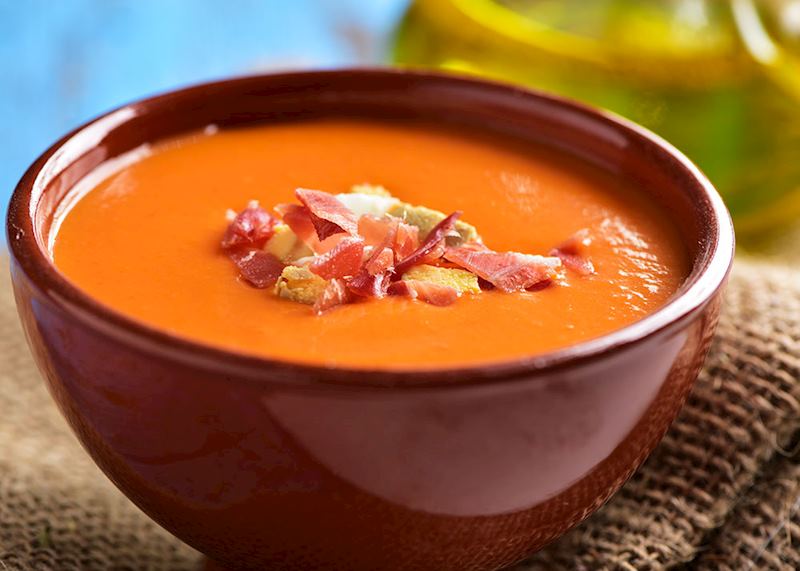
Like many traditional dishes, salmorejo’s origins have been lost in time. But history does recall an important shift. Tomatoes, imported from the New World, didn’t gain widespread acceptance in European cuisine until about the 18th century, at which time salmorejo shifted from blanco (white) to the creamy pink version you can find today.
You’ll spot it on menus around Spain, but especially in Córdoba, where it’s practically the signature dish. Cordobans have even emblazoned it on the city’s very walls. Deep in the Judería, in a little alley called Calleja del Salmorejo Cordobés, you’ll find a tile placard that outlines the basic recipe. At the end of the whitewashed lane, a small restaurant called La Fragua serves a traditional rendition based on the recipe. Their berenjenas con miel (fried eggplants with honey) are good, too.
Read more about trips to Spain
Start thinking about your experience. These itineraries are simply suggestions for how you could enjoy some of the same experiences as our specialists. They're just for inspiration, because your trip will be created around your particular tastes.
View All Tours in Spain

